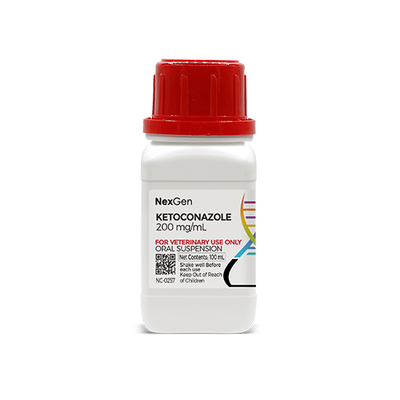
Metronidazole 150 mg/mL, Oral Suspension, 100mL
Login for pricing
- Brand
- NexGen
- SKU:
- NC-0098
- Product Type:
- Suspension
- Size:
- 100ml
- Administration:
- Oral
Chronic diarrhea, recurrent colic, and weight loss in horses and foals are often attributed to large and small strongyles, which are common worm infestations. However, giardiasis (giardia) has been reported in some cases as a cause of some of these symptoms in horses. Giardia can also be found in the feces of healthy horses however, but is rarely recognized as a cause of diarrhea.1
Giardia (Giardia duodenalis) are small, flagellated protozoal organisms that infect the small intestine of many mammals, including horses. Recent research in several countries suggests that infection giardiasis is more common than the conventional wisdom has maintained, which could put young foals and even their human handlers at risk.2
Giardia in Horses
Historical data indicate that approximately 0.5-35% of horses worldwide are infected with Giardia duodenalis. This is the most common species of giardia to infect horses, humans, dogs, and cats. After horses ingest the giardia cysts, the parasite hatches or encysts, gaining the ability to mobilize and attach to the lining of the wall of the small intestine. Once attached, it begins acquiring nutrients and reproducing, some of which form cysts excreted in the horse’s feces.3
Giardiasis is zoonotic, meaning that humans exposed to infected animals are also at risk of developing the infection. Giardia can cause diarrhea, ill thrift, poor coat, weight loss, and other common signs of intestinal parasitism in horses. Some infected foals shedding giardia cysts may not show signs of diarrhea, but they are still capable of infecting other animals, including humans. This presents the potential for a continuous cycle of transmission in a facility, especially when overcrowding is an issue.
Anaerobic Bacterial Infections in Horses
Anaerobic bacteria (bacteria which can flourish without the presence of oxygen) are often overlooked bacterial pathogens of the lower respiratory tract in horses.4 There are literally hundreds of anaerobic bacterial isolates that have been found in the pharyngeal tonsillar surface of healthy horses4; as with many bacterial infections, it is thought that immunocompromised states allow such bacteria to proliferate.
In equine medicine, the term bronchopneumonia is often used to refer to lower respiratory tract infections, whether the infection is localized to the bronchi or the infection involves both the bronchi and the lung parenchyma.5 When there is subsequent extension of the infection from the pulmonary parenchyma to the visceral pleura and pleural space, the disease is referred to as pleuropneumonia. The spectrum of clinical signs shown by horses with bronchopneumonia is broad and reflects the severity of the disease process. Early identification of affected animals and immediate initiation of appropriate therapy are essential to prevent mortality and functional impairment of the respiratory system.4 Unfortunately, antimicrobials specifically targeting anaerobic pathogens are often not routinely employed.
Where to buy Metronidazole Benzoate
Metronidazole benzoate is available in the U.S. through several pharmaceutical manufacturers and through veterinary custom compounding companies.
Metronidazole carries several potential drug interactions. Please consult your veterinarian prior to beginning any treatment regimen.
FOR RX ONLY: A valid prescription from a licensed veterinarian is required for dispensing this medication.
3Kirkpatrick C.E., Skand DL. Giardiasis in a horse. J Am Vet Med Assoc. 1985 Jul 15;187(2):163-4.
4Sweeney C.R., et. al. Anaerobic bacteria in 21 horses with pleuropneumonia. J Am Vet Med Assoc. 1985 Oct 1;187(7):721-4.




















